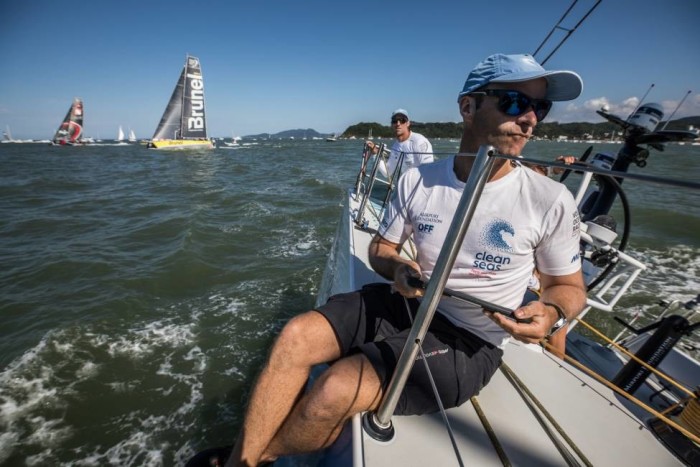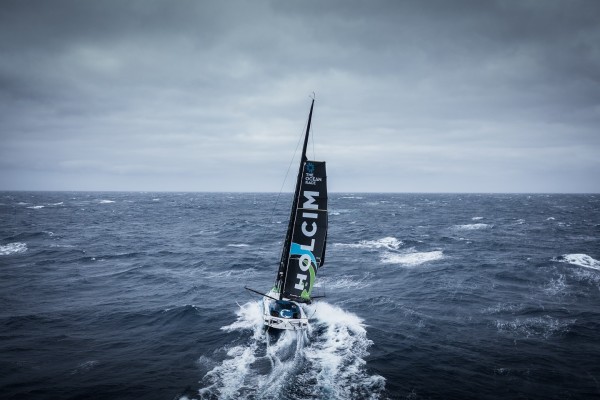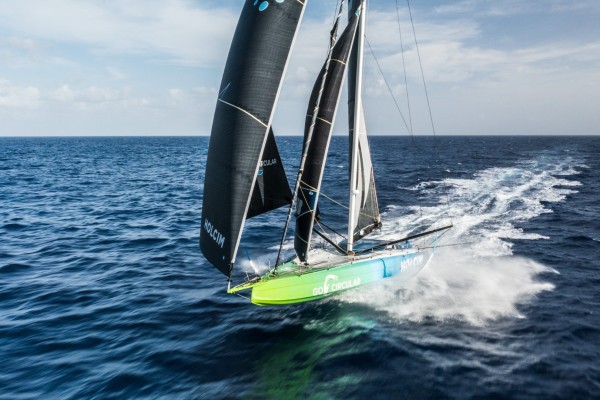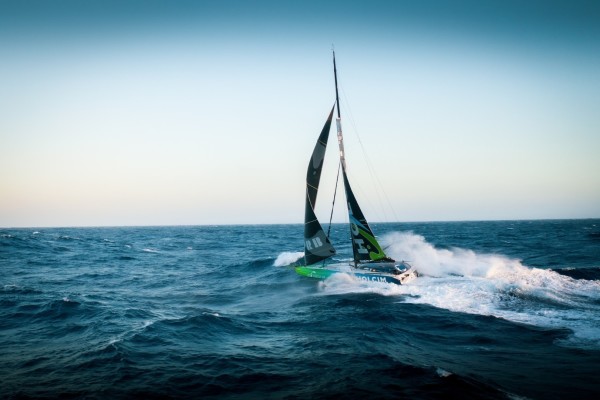Volvo Ocean Race
Leg 8 Itajai - Newport: a 4-phase leg
Sailing at the front of the fleet feels good!
We left Itajaí and beat along the Brazilian coast in a fairly variable, medium wind (10-15 knots), with a fair few clouds and squalls bringing their share of fluky shifts. We’d come off pretty well in this little game and we were leading as far as the doldrums. Even though the end result is quite disappointing, especially after such a fine start to the race, it felt good to be heading the fleet for a few days.
During this climb along the Brazilian coast, we traversed areas of oil and gas exploration. It’s impressive to see so many workboats in a fairly restricted area, where the continental shelf rises (edge of the blue background / white background on the image below). We had to get right up close and slalom amongst all these boats at times.

On this screenshot of the Adrena software, the red zones were completely forbidden to navigation.
Alert amongst the Sargasso weed
Once we’d left Brazil, we traversed the doldrums without any great difficulty: at this longitude and at this time of year, it’s not generally very tough. Once we were through to the other side, we had to face up to another enemy entirely: between the Transat AG2R-La Mondiale and the Volvo Ocean Race, the Sargasso weed is beginning to make a name for itself! This weed is a real drag for the Figaro sailors in the Transat. Indeed, at the speed of a Figaro, it’s very easy to get it caught around the keel and the rudders. It’s a different ball game on the Volvo 65s, as we were lucky enough to traverse this infested zone at an average speed of around twenty knots and, at this pace, the weed doesn’t get hooked around our appendages so easily. However, this Sargasso weed really is a scourge! As far as I can grasp, it comes mainly from the Amazon River and as a result of the massive deforestation, the rainwater drains more easily into the sea, carrying with it rather undesirable nutriments (phosphates, nitrates…) resulting from intensive farming. All that creates an environment that favours the development of this weed, which then drifts towards the Caribbean Sea, carried by the North Equatorial Current. It’s a catastrophe for the West Indies, which sees its heavenly beaches soiled by these layers of weed, which wash up there and give off a heady odour of rotten egg…

Using satellites (image above), we can now get a view of the Sargasso weed from space. It makes for a sorry sight in this image, which encompasses the North-East of South America and the Lesser Antilles.
The Gulf Stream and its effects
Continuing our climb up the North Atlantic Ocean, we gradually close on the Gulf Stream. I’ve heard tell of it from a very early age, but for us Europeans, this Gulf Stream has nothing concrete about it. By all accounts, it brings us a current of warm water that crosses the Atlantic and graces us with a rather special climate along metropolitan France’s western seaboard. However, in reality you can’t visualise it at all!
On the other side of the Atlantic, it’s quite another story. We had the opportunity to cross paths with it during this leg. We traversed a band of current that’s around 30 to 50 miles wide and rotates through to the ENE at 5-6 knots! The water within the Gulf Stream is around 22-23°C, but as soon as you leave it, you fall into a kind of ‘counter-current’ coming from Saint-Pierre-et-Miquelon and heading over to the South-West. The speed of the latter current is fairly slow. However, the temperature of the water drops to 8°C in just two or three hours! Change of setting: whoever refers to cold water at this time of year where the climate gets milder, inevitably refers to fog!

In this screenshot from the Adrena software, the arrows illustrate the current and the coloured area illustrates the water temperature: with a sudden change to the North of the Gulf Stream!
The Mecca of Newport!
The approach towards Newport is the next obstacle to be negotiated in a peasouper and very light wind. Once again, we witnessed a bunching up of the whole fleet where the river flows around Newport, the front runners becoming becalmed and stumbling against the current whilst their pursuers managed to make up their deficit and tried their luck with a different tactic. At this particular game, we didn’t come off great as we finished 6th, just a few dozen minutes shy of Mapfre, winner of this leg, whose crew was the shrewdest in the race to the finish.
At that point, it was time to explore Newport, the Mecca of sailing in the United States, with its strong historical ties with the America’s Cup. Moreover, the main street of this town goes by the name America’s Cup Road. The shops nearly all display race posters in their windows, people recognize us and call out to us in the street and you come across 12 mJIs there, together with boats like Rambler 88; the latter currently in refit there… In short, Newport is indeed the Mecca of sailing along America’s eastern seaboard!

In Newport, in the state of Rhode Island, life revolves around sailing in general and the America’s Cup in particular. Twelve editions of the latter have taken place here between 1930 and 1983!
VOLVO OCEAN RACE 2018-2019
Ranking for the 8th leg Itajai-Newport (5,700 miles)
1. Mapfre (Xabi Fernandez) 15 days 17 hours 44 minutes and 29 seconds
2. Team Brunel (Bouwe Bekking) 1’01’’ behind
3. Vestas 11th Hour Racing (Charlie Enright) 14’35’’ behind
4. Dongfeng Race Team (Charles Caudrelier) 40’52’’ behind
5. Team AkzoNobel (Simeon Tienpont) 1h 36’ behind
6. Turn the Tide on Plastic (Dee Caffari) 1h 39’ behind
7. Sun Hung Kai/Scallywag (David Witt), 3h 12' behind
Overall ranking after 8 legs
1. Mapfre: 53 points
2. Dongfeng Race Team: 50 points
3. Team Brunel: 42 points
4. Team AkzoNobel: 36 points
5. Vestas 11th Hour Racing: 28 points
6. Sun Hung Kai/Scallywag: 27 points
7. Turn the Tide on Plastic: 22 points
The start of the 9th leg between Newport (United States) and Cardiff (Wales) will set sail on Tuesday 22 May 2018.




